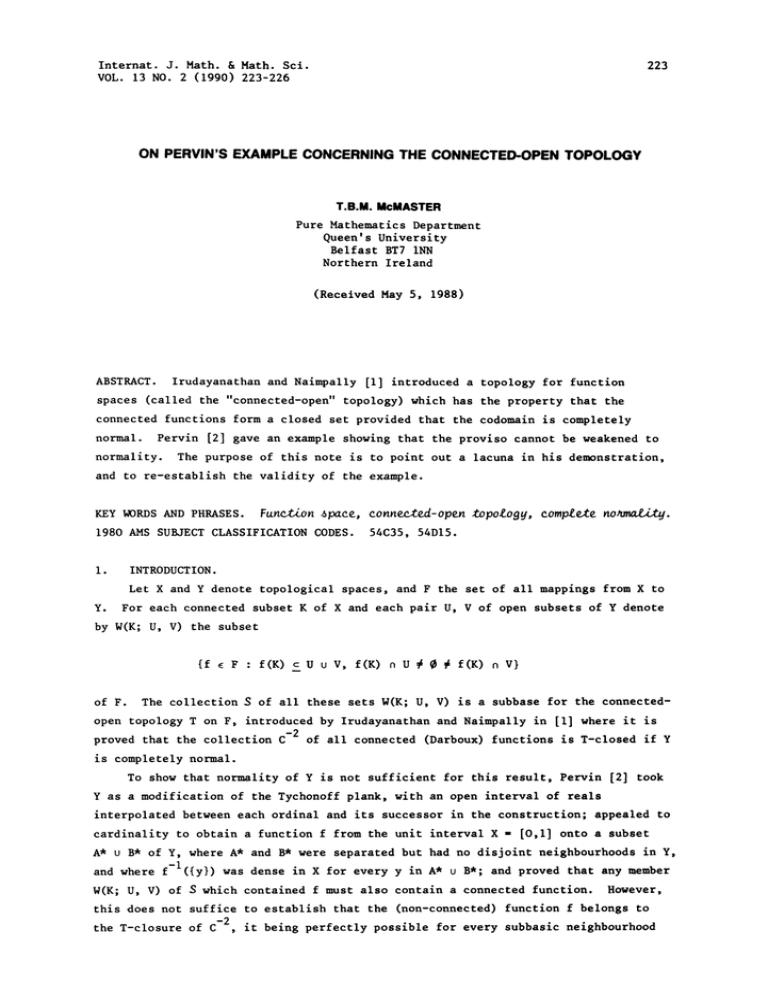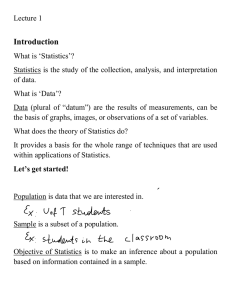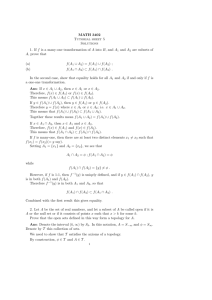EXAMPLE CONCERNING THE CONNECTED-OPEN TOPOLOGY
advertisement

Internat. J. Math. & Math. Sci.
VOL. 13 NO. 2 (1990) 223-226
223
ON PERVIN’S EXAMPLE CONCERNING THE CONNECTED-OPEN TOPOLOGY
T.B.M. McMASTER
Pure Mathematics Department
Queen’ s University
Belfast BT7 INN
Northern Ireland
(Received May 5, 1988)
ABSTRACT.
Irudayanathan and Naimpally [i] introduced a topology for function
spaces (called the "connected-open" topology) which has the property that the
connected functions form a closed set provided that the codomain is completely
normal.
Pervin
normality.
[2] gave
an example showing that the proviso cannot be weakened to
The purpose of this note is to point out a lacuna in his demonstration,
and to re-establish the validity of the example.
Function space, connected-open topology, complete normality.
KEY WORDS AND PHRASES.
1980 AMS SUBJECT CLASSIFICATION CODES.
54C35, 54D15.
INTRODUCTION.
1.
Let X and Y denote topological spaces, and F the set of all mappings from X to
Y.
For each connected subset K of X and each pair U, V of open subsets of Y denote
by W(K; U, V) the subset
{f
of F.
F
f(K)
U u V, f(K) n U # # # f(K) n V}
The collection S of all these sets W(K; U, V) is a subbase for the connected-
open topology T on F, introduced by Irudayanathan and Naimpally in [I] where it is
-2
of all connected (Darboux) functions is T-closed if Y
proved that the collection C
is completely normal.
To show that normality of Y is not sufficient for this result, Pervin
[2]
took
Y as a modification of the Tychonoff plank, with an open interval of reals
interpolated between each ordinal and its successor in the construction; appealed to
cardinality to obtain a function f from the unit interval X
[O,I] onto a subset
A* u B* of Y, where A* and B* were separated but had no disjoint neighbourhoods in Y,
and where f-l({y}) was dense in X for every y in A* u B*; and proved that any member
W(K; U, V) of S which contained f must also contain a connected function. However,
this does not suffice to establish that the (non-connected) function f belongs to
the T-closure of C
-2,
it being perfectly possible for every subbasic neighbourhood
T.B.M. MCMASTER
224
of a point to intersect a set without every basic neighbourhood doing so.
We shall
show that f is, nevertheless, a limit of connected (indeed, of continuous) functions.
2.
PERVIN’S EXAMPLE REVISITED.
Let J denote the connected, compact T space formed from the second uncountable
2
by interpolating a copy of (O,I) between each element (other than the
ordinal
WD
maximum) and its successor, and imposing the order topology on the resulting chain;
and consider the product space Y
Jx[O,l]. (The space W used here by Pervin
[O,I]
instead of
is homeomorphic to
[O,I] .)
Denote by a and b (respectively) the
least and greatest elements of J, and by A* and B* the following subsets of Y:
A*
[a,b){l}, B*
{b}x [0, I).
(Pervin’s definition of these sets is incompatible with his assertion that they are
connected; the above is presumably what was intended.) Considerations of cardinality
establish the existence of a mapping f from ,I] onto A* u B* such that the preimage
of each singleton is dense.
It will now be shown that every neighbourhood of f
contains a connected function.
Consider a typical basic T-neighbourhood
G
of f
n{W(Ki;
U i, V i)
i-- I, 2,
where (for each i) K. is a connected subset of
I
and f(K
i)
n}
[O,i],
U. and V. are open in Y,
I
i
is contained in the union of U I and V.1 and meets them both.
generality will be incurred by assuming that the sets K. are distinct
W(K; U, V) n W(K; U’, V’)
W(K; U o U’, V
No loss of
since
V’).
n, we
the number of degenerate intervals amongst the Ki, where O s
is
and
non-degenerate
for
i
a
K.
singleton
is
so
that
labelling
the
can arrange
i
for i > j. The strategy of the proof is to determine a subset Z of Y of the form
Denoting by
suggested by a876e8 in the diagram below (which see), where x is chosen to ensure
j, and z is selected so that Z includes
that Z is contained in U.I u V. for all i
n V. for each i; a path-connectedness argument within Z will
at least one point of
U
then produce a continuous function belonging to G.
is the whole of A* u B* and is contained in
For i > j, f(K
i)
U
u V..
Thus for
each positive integer n the product of compact sets
{b}x[O,l-2 -n]
and a lemma of A.D. Wallace (see [3], p.142) allows us to
is contained in U.i u V.,
1
find x.
l,n
[a,b) such
(Xi,n’ b]x[O
that
I-2 -n] cU. uV..
i
225
PER/IN’S EXAMPLE CONCERNING THE CONNECTED-OPEN TOPOLOGY
[0,1]
B*
0
a
J
z
b
Fi E_ur e I.
Now
[a,b) inherits from its cofinal subset
Wfl
\ {b} the property that each countable
subset is bounded above: choosing then a strict upper bound x. < b for the sequence
(xi, n)
we see that
[xi,b][0,1) ! Ui
u
Vi;
and so if x denotes the maximum of the elements x. here chosen, we have
[x,b]x[O,l)
for all i
U. u V.
j.
(2.1)
n, i.e. that all the K. are degenerate, (2.1) may be obtained
(In the event that
by an arbitrary choice of x
b.)
Still considering the case i
j, we see from (2.1) that the connected set
A* u (x,b]x[O,l) is contained in the union of U.1 and V.1 and intersects them both;
(t(i) I, t(i) 2) of U i n V i such
so it must be possible to choose a point t(i)
that either t(i) e A*, or else t(i) e (x,b]x[O,l): and in the latter case, the
observations that U. n V. is a neighbourhood of t(i) and that b is not isolated in J
1
I
will allow us to assume that x
t(i)l
< b.
is here a single point of (A* u B*) n U i s
Turning now to the case i
Vi;
j, f(K i)
if this point lies in A* we denote it
T.B.M. MCMASTER
226
by t(i)
will
(t(i)l t(i)2), while
yield t(i)
(t(i)l t(i)2
z denote the maximum of
if it belongs to B*, an argument like that above
in U
i
t(l}l t{2)l
n V
i satisfying x
b.
t(i)l
Lastly let
t{n} I" the consequence of the choices of x
and of z is that the set
Z
[a,zlx{1} u [x, z] [O,1]
includes the point t(i) of U a V. for every i, and is contained in U. u V. for those
I
1
1
1
values of i (if any) for which K
Now since z
Wa
<
i
is non-degenerate.
b, the interval (x,z) contains only countably many elements of
and only countably many interpolated real intervals or parts thereof, so it
possesses a countable dense subset.
It is routine to verify that it contains a
supremum and an infimum for each of its bounded subsets, and it has no least nor
greatest element and no gaps.
Thus by a well-known characterization due to
Hausdorff ([4], p. 54) it is homeomorphic to the real line.
Then Ix,z] and,
similarly, [a,z] are homeomorphic to bounded closed real intervals; and Z, being
essentially the unit square in the real plane with a line segment attached to one
corner, is path-connected.
Choosing distinct elements k. in K.1 for each i, which
1
will be possible since the K. are themselves distinct intervals
1
this guarantees
the existence of a continuous (and therefore connected) function g
such that
g(ki)
t(i) for each i.
is common to all the sets
ACKNOWLEDGEMENT.
[O,I]
Z
Regarding g as a mapping into Y, we see that it
W(Ki; Ui, Vi)
and the demonstration is complete.
The author would like to express his gratitude to Mr. Patrick
O’Hanlon for bringing the problem to his attention, and for many valuable
conversations.
REFERENCES
I.
IRUDAYANATHAN, A. and NAIMPALLY, S.
spaces, Indag. Math.,
Connected-open..topology for function
28 (= Proc. Kon. Ned. Akad. v. Wetensch., A69) (1966),
22-24.
2.
PERVIN, W.J. On the connected-open topology, Indag. Math., 29 (= Proc. Kon.
Ned. Akad. v. Wetensch., A70) (1967), 126-127.
3.
KELLEY, J.L. General Topolog_y, Van Nostrand, 1955.
4.
HAUSDORFF, F. l.engenlehre (3rd edition), Dover Publications, 1947.

![MA342A (Harmonic Analysis 1) Tutorial sheet 2 [October 22, 2015] Name: Solutions](http://s2.studylib.net/store/data/010415895_1-3c73ea7fb0d03577c3fa0d7592390be4-300x300.png)




